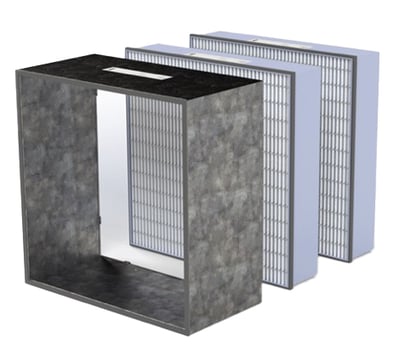Airborne molecular contamination (AMC) threatens semiconductor yield and reliability. Learn how Entegris helps fabs detect and control AMC with advanced filtration and data-driven strategies.
|
When we think of cleanroom air quality, our minds often jump to particles like dust, bacteria, and viruses. Each of these are effectively captured by HEPA and ULPA filters. However, in semiconductor manufacturing, there's a more elusive and insidious threat: airborne molecular contamination (AMC). These gas-phase contaminants, present in parts-per-billion concentrations, can silently degrade wafer surfaces, interfere with photolithography processes, and compromise equipment performance and reliability. |
Figure 1 AMC concentration example. |
What Is AMC Control?
AMC consists of trace gases that include acids, bases, organics, and reactive compounds. Unlike particles, these molecules are small enough to pass through traditional particle filters and can chemically interact with sensitive surfaces during semiconductor processing. The result? Wafer-defects, yield loss, and equipment degradation.
Real-World Impact on Semiconductor Fabs
In cleanrooms, AMC can:
- Alter photolithography results in DUV and EUV processes.
- Corrode metal interconnects, leading to early device failure.
- Contaminate exposure optics, etch and deposition chambers, reducing tool uptime and increasing maintenance.
How AMC Filters Work
AMC filters, more accurately called purifiers, use specialized adsorbents to capture and neutralize gas-phase contaminants. There are three main types:
- Physical Adsorbents: Use weak intermolecular forces; low-cost but reversible and less effective.
- Chemical Adsorbents: React with contaminants to form stable compounds; highly efficient and irreversible.
- Catalytic Adsorbents: Break down contaminants into harmless compounds like CO₂ and H₂O; highly effective but expensive.
Entegris, a leader in AMC control, combines physical and chemical adsorbents to tailor filtration solutions for specific fab environments and optimized cost of ownership.
The “See It. Control It.” Approach
Entegris emphasizes a two-step strategy:
- See It: Measure and analyze AMC levels using ISO/IEC 17025-accredited laboratories to analyze in-field air samples.
- Control It: Remove AMC by designing and deploying customized AMC filters based on the measured, specific contamination profile of the fab.
This data-driven approach ensures that filters are not only effective but also optimized for cost of ownership (CoO), with performance monitoring over time, which enables replacement only when necessary. Entegris has helped fabs extend filter lifetimes, reduce changeout frequency, and improve process stability by tailoring AMC solutions to their unique environments.
Challenges and Future Directions
AMC filtration is a balancing act. Higher removal efficiency requires more adsorbent, which increases cost, weight, and pressure drop, impacting airflow and energy efficiency. Entegris is addressing these challenges through:
- Materials Innovation: Developing adsorbents with targeted pore sizes and chemical reactivity.
- Sustainability: Creating recyclable and longer-lasting filtration media.
- Customization: Designing filters that fit specific tools, processes, and contamination profiles.

Figure 1 Entegris AMC Filter design
Conclusion
As a premier materials company, Entegris offers a comprehensive portfolio of AMC filtration and analysis, customized products, and ongoing monitor-ing that is unique to many industries. No other AMC filter provider effectively addresses these require¬ments. New applications for these capabilities are being discovered all the time, as businesses and industries that weren’t previously focused on airborne molecular contamination understand the damage it can cause and why they cannot neglect addressing AMC. Customers turn to Entegris to leverage its expertise in developing a targeted solution to mitigate AMC and its impact on people, products, and processes. Explore Entegris’ Analytical Services and AMC Filters to start building your contamination control strategy today. Read the AMC Fundamentals paper and contact our experts.





